AMD's Sempron 3300+: 90nm Budget Computing
by Anand Lal Shimpi on April 18, 2005 2:10 AM EST- Posted in
- CPUs
Workstation Applications
SPECviewperf 8
For our next set of professional application benchmarks, we turn to SPECviewperf 8. SPECviewperf is a collection of application traces taken from some of the most popular professional applications, and compiled together in a single set of benchmarks used to estimate performance in the various applications that the benchmark is used to model. With version 8, SPEC has significantly improved the quality of the benchmark, making it even more of a real world indicator of performance.
We have included SPEC's official description of each one of the 8 tests in the suite.
Not too surprising is the strong performance of the Sempron here; the chip's on-die memory controller ensures very good performance in all of the SPECviewperf tests.
3dsmax Viewset (3dsmax-03)
"The 3dsmax-03 viewset was created from traces of the graphics workload generated by 3ds max 3.1. To ensure a common comparison point, the OpenGL plug-in driver from Discreet was used during tracing.
The models for this viewset came from the SPECapc 3ds max 3.1 benchmark. Each model was measured with two different lighting models to reflect a range of potential 3ds max users. The high-complexity model uses five to seven positional lights as defined by the SPECapc benchmark and reflects how a high-end user would work with 3ds max. The medium-complexity lighting models use two positional lights, a more common lighting environment.
The viewset is based on a trace of the running application and includes all the state changes found during normal 3ds max operation. Immediate-mode OpenGL calls are used to transfer data to the graphics subsystem."
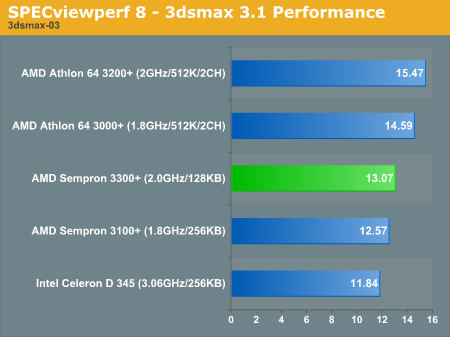
CATIA Viewset (catia-01)
"The catia-01 viewset was created from traces of the graphics workload generated by the CATIATM V5R12 application from Dassault Systems.
Three models are measured using various modes in CATIA. Phil Harris of LionHeart Solutions, developer of CATBench2003, supplied SPEC/GPC with the models used to measure the CATIA application. The models are courtesy of CATBench2003 and CATIA Community.
The car model contains more than two million points. SPECviewperf replicates the geometry represented by the smaller engine block and submarine models to increase complexity and decrease frame rates. After replication, these models contain 1.2 million vertices (engine block) and 1.8 million vertices (submarine).
State changes as made by the application are included throughout the rendering of the model, including matrix, material, light and line-stipple changes. All state changes are derived from a trace of the running application. The state changes put considerably more stress on graphics subsystems than the simple geometry dumps found in older SPECviewperf viewsets.
Mirroring the application, draw arrays are used for some tests and immediate mode used for others."
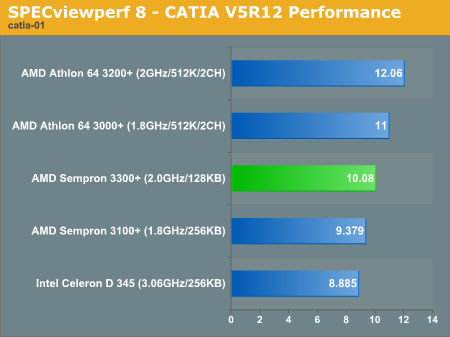
Lightscape Viewset (light-07)
"The light-07 viewset was created from traces of the graphics workload generated by the Lightscape Visualization System from Discreet Logic. Lightscape combines proprietary radiosity algorithms with a physically based lighting interface.
The most significant feature of Lightscape is its ability to simulate global illumination effects accurately by precalculating the diffuse energy distribution in an environment and storing the lighting distribution as part of the 3D model. The resulting lighting "mesh" can then be rapidly displayed."
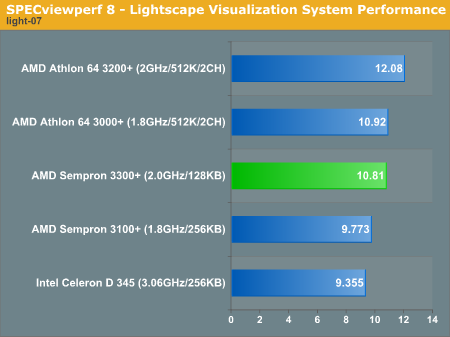
Maya Viewset (maya-01)
"The maya-01 viewset was created from traces of the graphics workload generated by the Maya V5 application from Alias.
The models used in the tests were contributed by artists at NVIDIA. Various modes in the Maya application are measured.
State changes as made by the application are included throughout the rendering of the model, including matrix, material, light and line-stipple changes. All state changes are derived from a trace of the running application. The state changes put considerably more stress on graphics subsystems than the simple geometry dumps found in older viewsets.
As in the Maya V5 application, array element is used to transfer data through the OpenGL API."
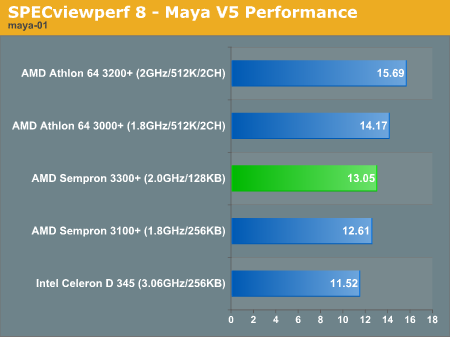
Pro/ENGINEER (proe-03)
"The proe-03 viewset was created from traces of the graphics workload generated by the Pro/ENGINEER 2001TM application from PTC.
Two models and three rendering modes are measured during the test. PTC contributed the models to SPEC for use in measurement of the Pro/ENGINEER application. The first of the models, the PTC World Car, represents a large-model workload composed of 3.9 to 5.9 million vertices. This model is measured in shaded, hidden-line removal, and wireframe modes. The wireframe workloads are measured both in normal and antialiased mode. The second model is a copier. It is a medium-sized model made up of 485,000 to 1.6 million vertices. Shaded and hidden-line-removal modes were measured for this model.
This viewset includes state changes as made by the application throughout the rendering of the model, including matrix, material, light and line-stipple changes. The PTC World Car shaded frames include more than 100MB of state and vertex information per frame. All state changes are derived from a trace of the running application. The state changes put considerably more stress on graphics subsystems than the simple geometry dumps found in older viewsets.
Mirroring the application, draw arrays are used for the shaded tests and immediate mode is used for the wireframe. The gradient background used by the Pro/E application is also included to better model the application workload."
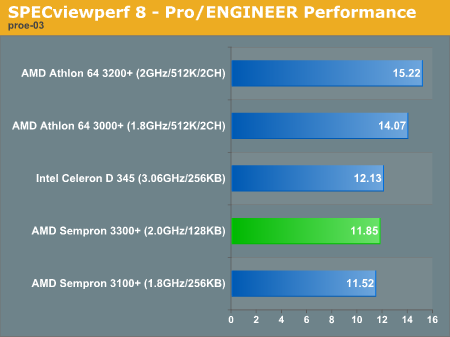
SolidWorks Viewset (sw-01)
"The sw-01 viewset was created from traces of the graphics workload generated by the Solidworks 2004 application from Dassault Systemes.
The model and workloads used were contributed by Solidworks as part of the SPECapc for SolidWorks 2004 benchmark.
State changes as made by the application are included throughout the rendering of the model, including matrix, material, light and line-stipple changes. All state changes are derived from a trace of the running application. The state changes put considerably more stress on graphics subsystems than the simple geometry dumps found in older viewsets.
Mirroring the application, draw arrays are used for some tests and immediate mode used for others."
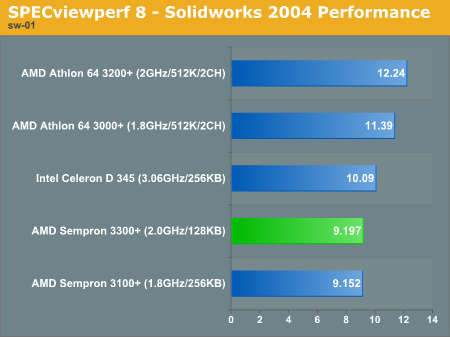
Unigraphics (ugs-04)
"The ugs-04 viewset was created from traces of the graphics workload generated by Unigraphics V17.
The engine model used was taken from the SPECapc for Unigraphics V17 application benchmark. Three rendering modes are measured -- shaded, shaded with transparency, and wireframe. The wireframe workloads are measured both in normal and anti-alised mode. All tests are repeated twice, rotating once in the center of the screen and then moving about the frame to measure clipping performance.
The viewset is based on a trace of the running application and includes all the state changes found during normal Unigraphics operation. As with the application, OpenGL display lists are used to transfer data to the graphics subsystem. Thousands of display lists of varying sizes go into generating each frame of the model.
To increase model size and complexity, SPECviewperf 8.0 replicates the model two times more than the previous ugs-03 test."
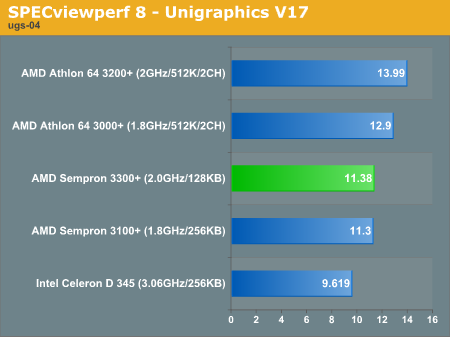










53 Comments
View All Comments
johnsonx - Monday, April 18, 2005 - link
AMD's web site implies that Cool'n'Quiet works with S754 Semprons (for example when you click on downloads for the Sempron processors, you get several revisions of the AMD cpu driver that claim to enable Cool'n'Quiet). However I've tried enabling it on a couple of S2600's, and have had no luck. I had no trouble getting it to work on my A64 2800+, so I assume that Semprons in fact do have cool'n'quiet disabled.I think this is stupid of course, but my opinion of what's stupid obviously carries little weight with AMD...
randomman - Monday, April 18, 2005 - link
Nitpick: Xvid isn't at Version 5 - the lastest stable is 1.0 and beta is at 1.1. Which is it?Jep4444 - Monday, April 18, 2005 - link
Palermo which is based off of VeniceAsiLuc - Monday, April 18, 2005 - link
Is this the Venice or the Winchester core?Jep4444 - Monday, April 18, 2005 - link
beat me to it eBauer, the A64 2800+ really should have been tested(ive yet to see anyone use one in a comparison versus the Sempron 3300+ yet which has been annoying me)overclockingoodness - Monday, April 18, 2005 - link
#19 AtaStrumf:"As for X800XT distorting the gaming value CPU picture, I think this is something worth thinking about. Maybe you should include a test with a 6600GT, just to see if a more expensive CPU, coupled with a value graphics card actually makes any difference."
Uh, that doesn't make any sense. You won't be able to compare the high-end and low-end chips since they will perform identially on the mid-end graphics solutions. Regardless of how fast the FX55 is, when you add that with a 6600GT - the performance will degrade. Besides, all high end chips will perform almost exactly the same because GPU will be the bottleneck.
What part of bottleneck do you guys not get?
Zebo - Monday, April 18, 2005 - link
Those complaining about overclocks...as usual YMMV, don't take one site as gospel, all chips clock differently. Best resource to get an accurate representation is internet forums to get a cross section of the pioneers who took the chance for y'all. Another thing to keep in mind is Anandtech is'nt xtremesystems, they use safe low volts, and go for real stability, basically your average guy type overclock not screenshot overclocks.Zebo - Monday, April 18, 2005 - link
Makes you wonder what an AMD FX with 2MB lvl2 Cache would do???eBauer - Monday, April 18, 2005 - link
I would have liked to see a A64 2800+ thrown into a mix, especially considering it shares roughly the same price as the new sempron 3300+.Including the 2800+ would have given readers a clear view on why the 3000/3200 939 cpus had the advantage (if it were due to the 512k cache, dual channel memory, or a combination of the two)
Avalon - Monday, April 18, 2005 - link
My sempy 2800+ did 2.72ghz on 1.55v, so Anand must have gotten a real dud of a chip. Also, to those wondering about HTPC applications for this chip. I'm pretty positive that CnQ is disabled for semprons, and only available for the A64 line. I've been starting to realize more and more that dual channel is really beneficial to gaming on the K8 platform. There really does seem to be no reason to grab a s754 Sempron anymore, since they don't offer any significant price savings. I'm still glad I got to play with one, but I'll be much happier with a dual channel Venice.